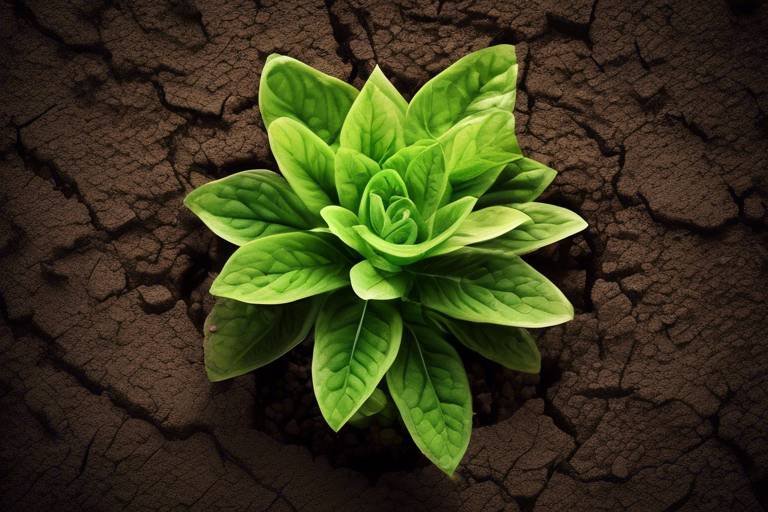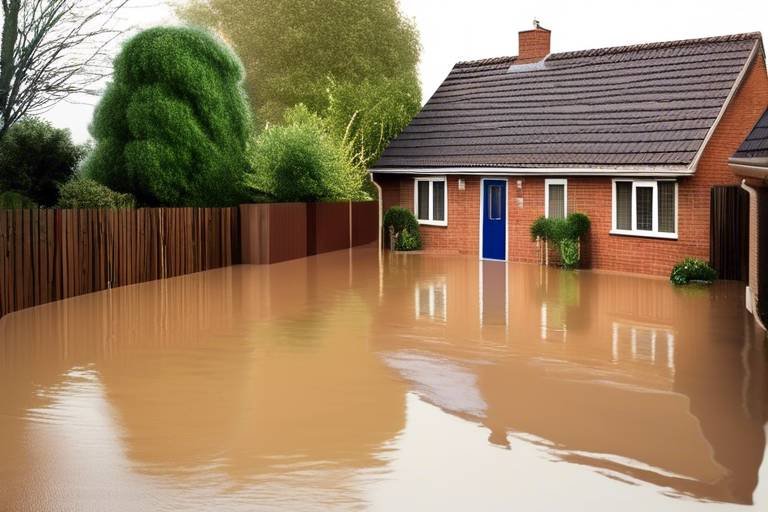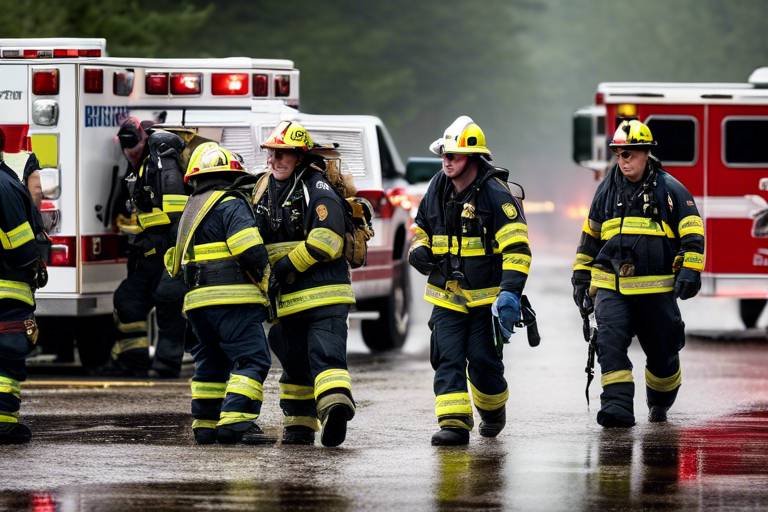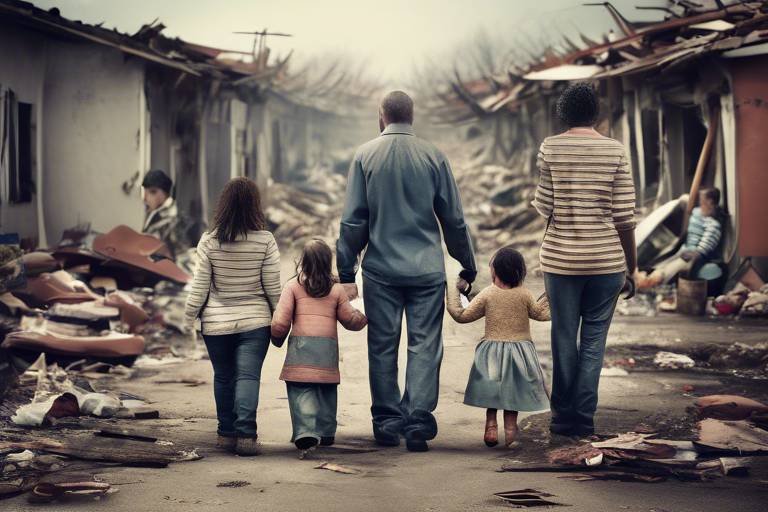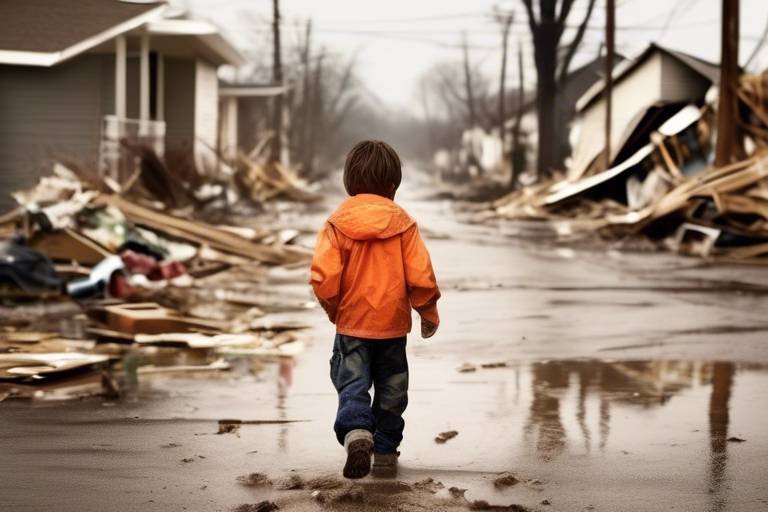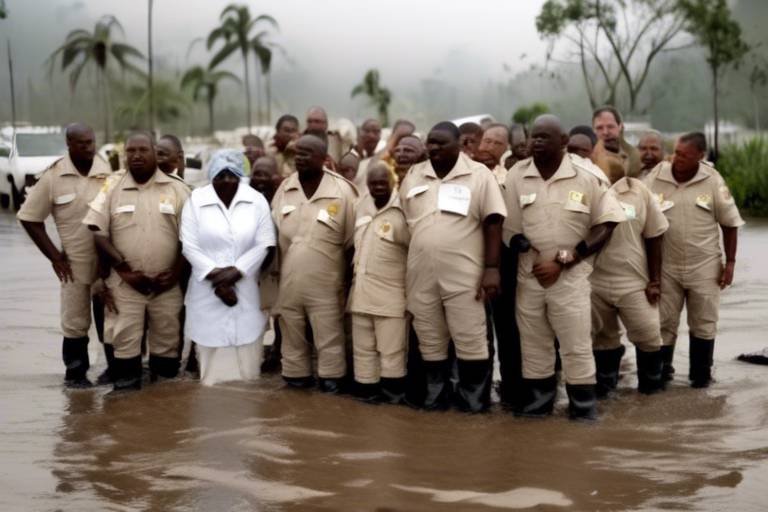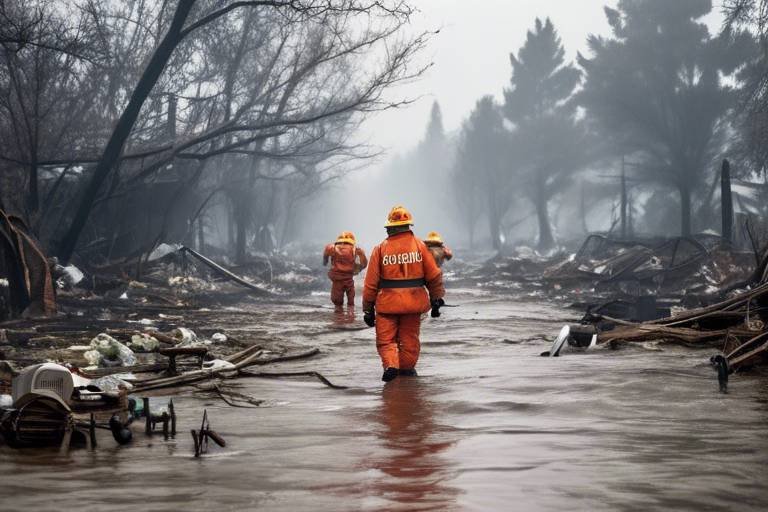How Can Plants Help in Emergency Preparedness?
In a world where unpredictability reigns, being prepared for emergencies is more crucial than ever. But did you know that the humble plant can play a pivotal role in enhancing our emergency preparedness strategies? From providing essential food supplies to serving as natural medicine, plants are not just decorative—they're vital lifelines during crises. Imagine a scenario where grocery stores are empty, or medical supplies are scarce; having a solid understanding of local flora can mean the difference between survival and struggle.
Plants contribute to our resilience in ways that extend beyond mere sustenance. They can improve mental health, create environmental stability, and foster community spirit. When we think of emergency preparedness, we often visualize stockpiling canned goods or gathering flashlights, but incorporating plants into our strategies can yield benefits that are both practical and profound. This article dives into the myriad ways plants can bolster our readiness for emergencies, ensuring that we not only survive but thrive in the face of adversity.
When traditional supply chains are disrupted, having access to nutritious food sources becomes paramount. Plants can serve as a reliable food source during emergencies, offering essential nutrients that keep our bodies strong. For instance, consider the power of a garden filled with vegetables, fruits, and herbs. These plants can provide sustenance not just for individuals but for entire communities when external food supplies are compromised.
Moreover, growing your own food can enhance food security in several ways:
- Self-Sufficiency: Cultivating edible plants reduces reliance on external food sources.
- Nutrition: Homegrown produce is often fresher and more nutritious than store-bought options.
- Variety: Growing diverse plants can ensure a balanced diet even in tough times.
By incorporating plants into our emergency preparedness plans, we can create a buffer against food shortages and ensure that our communities remain nourished and healthy.
In addition to providing food, many plants possess healing properties that can be invaluable during emergencies. When medical supplies are limited, understanding how to utilize local medicinal plants can empower individuals to address common ailments. For example, plants like aloe vera can soothe burns, while chamomile can help alleviate anxiety and promote sleep.
Knowing which plants in your area have medicinal benefits is crucial. It’s like having a secret weapon at your disposal. Imagine being able to identify a plant that can relieve headaches or treat minor cuts and scrapes. This knowledge not only enhances personal health but also strengthens community resilience during crises.
Learning how to prepare and preserve medicinal plants ensures their availability when needed most. Techniques such as drying, tincturing, and infusing can extend the shelf life of these natural remedies. For instance, creating herbal teas or salves can provide quick relief in emergency situations.
However, it’s crucial to educate yourself about which plants are safe to use and which are toxic. Misidentifying a plant can lead to serious health risks, especially in emergencies when medical help may be out of reach. Always consult reliable sources and consider participating in local workshops to enhance your knowledge.
Let’s not forget about the mental aspect of emergencies. Plants have been shown to improve mental health, providing comfort and reducing stress. The simple act of tending to a garden or having houseplants can create a sense of normalcy and peace during turbulent times. Picture yourself surrounded by greenery, breathing in the fresh air; it’s a natural stress reliever.
Beyond personal benefits, plants contribute to environmental resilience. Planting trees and vegetation can mitigate the impacts of natural disasters, such as flooding and landslides. They act as natural barriers, absorbing excess rainwater and stabilizing soil. Communities that invest in green infrastructure are often better prepared for the challenges posed by climate change.
Establishing green spaces in urban areas can enhance community preparedness. These areas not only provide refuge during emergencies but also serve as locations for community gatherings and educational initiatives. Imagine a neighborhood park where people come together to learn about sustainable gardening practices; it fosters a sense of community and collective responsibility.
Engaging communities in planting initiatives strengthens social bonds. When people work together to cultivate plants, they build relationships and create a network of support. This sense of ownership and responsibility enhances collective preparedness, making communities more resilient in the face of adversity.
Q: How can I start growing my own medicinal plants?
A: Begin by researching plants that thrive in your local climate and have known medicinal benefits. Start small with a few pots or a small garden bed, and gradually expand as you gain confidence.
Q: Are all plants safe to use for medicinal purposes?
A: No, not all plants are safe. It's important to educate yourself on which plants are medicinal and which are toxic. Always consult a reliable source or expert before using a plant for medicinal purposes.
Q: How do plants improve mental health?
A: Interacting with plants can reduce stress, improve mood, and increase feelings of well-being. Activities such as gardening or simply being around greenery can have calming effects.

Food Security in Emergencies
When disaster strikes, whether it's a natural calamity like a hurricane or a man-made crisis such as a pandemic, one of the first things to falter is our food supply. Imagine being cut off from grocery stores, fresh produce, and the essentials you rely on daily. This is where plants come to the rescue, acting as a lifeline for communities facing food insecurity. They can serve as a reliable food source during emergencies, ensuring that people have access to nutritious options even when traditional supply chains are disrupted.
Plants not only provide food but also contribute to the overall resilience of a community. For instance, community gardens can become vital resources, where individuals can cultivate fruits and vegetables, creating a sustainable food source right in their neighborhoods. By growing their own food, communities can reduce dependency on external supplies, which are often unreliable during crises.
Moreover, the nutritional value of plants cannot be overstated. In times of emergency, it’s crucial to maintain a balanced diet to keep energy levels up and to support overall health. Plants, especially those rich in vitamins and minerals, can play a significant role in this. Here’s a quick look at some plants that can be easily cultivated and are packed with nutrients:
| Plant | Nutritional Benefits |
|---|---|
| Spinach | High in iron and vitamins A, C, and K |
| Tomatoes | Rich in lycopene, vitamin C, and potassium |
| Beans | Excellent source of protein and fiber |
| Carrots | High in beta-carotene and antioxidants |
In addition to growing food, understanding the principles of food preservation is essential. Techniques such as canning, drying, and fermenting can help communities store food for longer periods, ensuring they have access to nourishment even when fresh produce is scarce. With a little knowledge and effort, families can transform their gardens into a sustainable food source that supports their health and well-being.
It's also worth noting that during emergencies, food security isn't just about having enough to eat; it’s about having access to safe and healthy food options. This means that communities need to be aware of the potential for food contamination or spoilage, especially if traditional refrigeration methods fail. By focusing on plants that are resilient and can thrive in various conditions, communities can bolster their food security and ensure that they are prepared for whatever challenges may come their way.
In conclusion, plants are not just a source of food; they symbolize hope and resilience in the face of adversity. By investing time and resources into cultivating plants, communities can enhance their food security during emergencies, ensuring that everyone has access to the nutrition they need to survive and thrive.
- How can I start a community garden? - Begin by gathering interested neighbors, finding a suitable location, and discussing what crops to grow together.
- What are some easy plants to grow for beginners? - Consider starting with herbs like basil and parsley, or vegetables like radishes and lettuce, which are relatively easy to grow.
- How can I preserve food from my garden? - You can preserve food through methods like canning, freezing, or drying, depending on the type of produce.

Medicinal Plants for First Aid
In times of crisis, when access to conventional medical supplies may be limited, medicinal plants can be a game-changer. These natural wonders have been used for centuries to treat various ailments, and understanding their benefits can significantly enhance our emergency preparedness. Imagine having a first-aid kit filled not just with bandages and antiseptics, but also with the power of nature at your fingertips. From soothing burns to alleviating headaches, medicinal plants can provide a reliable alternative when you need it most.
For instance, consider the humble aloe vera. This succulent is renowned for its ability to heal burns and skin irritations. Its gel-like substance can be applied directly to the skin, offering instant relief. Similarly, the peppermint plant isn't just a delicious flavoring for your tea; its leaves can be brewed into a soothing tea that can help relieve headaches and digestive issues. By incorporating these plants into your emergency plan, you are not just preparing for the unexpected; you are empowering yourself with knowledge that can make a real difference.
However, it's essential to identify which plants are available in your local area and their specific medicinal properties. This knowledge can be the difference between a minor inconvenience and a major health issue during an emergency. For instance, plantain is a common weed that can be found in many backyards. Its leaves can be used to treat insect bites and stings, acting as a natural anti-inflammatory. By familiarizing yourself with local flora, you can tap into a resource that is often overlooked.
Understanding your local medicinal plants can feel like having a secret weapon in your back pocket. You might be surprised to learn that many of the plants you encounter daily have healing properties. For example, calendula, often seen in gardens, can be used to make a soothing ointment for cuts and scrapes. The key is to learn how to identify these plants correctly and understand how to use them effectively.
Once you've identified beneficial plants, the next step is to learn how to prepare and preserve them. Dried herbs can last for months, making them a valuable addition to your emergency supplies. For example, you can create a herbal salve using calendula and beeswax, which can be stored for future use. Additionally, making tinctures from plants like echinacea can provide immune support during flu season, ensuring you have a stock of natural remedies ready when you need them.
While the world of medicinal plants is fascinating, it’s crucial to approach it with caution. Not all plants are safe for consumption or topical use. Some can be toxic or cause allergic reactions. Educating yourself about which plants are safe and which to avoid is essential for your safety. For instance, while yarrow can be beneficial for stopping bleeding, its lookalikes may not be safe. Always consult reliable sources or a local herbalist before using any medicinal plants, especially in an emergency situation.
In conclusion, incorporating medicinal plants into your emergency preparedness plan can provide you with a wealth of natural remedies that can be invaluable when traditional medical supplies are scarce. By understanding local flora, mastering preparation techniques, and ensuring safety, you can create a robust first-aid strategy that utilizes the healing power of nature.
- What are some common medicinal plants I can grow at home?
Some easy-to-grow options include aloe vera, peppermint, and chamomile. - How can I learn more about local medicinal plants?
Consider joining local herbalist groups or attending workshops focused on foraging and plant identification. - Are there any risks associated with using medicinal plants?
Yes, some plants can be toxic or cause allergic reactions. Always do thorough research before use.

Identifying Local Medicinal Flora
Understanding the medicinal properties of local plants can be a game-changer in emergency situations. Imagine being in a crisis where access to conventional medicine is limited; knowing which plants can offer relief or healing can empower you and your community. Local flora often holds the key to natural remedies that have been used for generations. By identifying these plants, you can create a personal pharmacy right in your backyard!
First, it’s essential to familiarize yourself with the common medicinal plants in your area. For instance, aloe vera is renowned for its soothing properties on burns and skin irritations, while chamomile can help alleviate anxiety and promote sleep. But how do you go about identifying these plants? A few steps can make this process easier:
- Research: Start by exploring local guides or resources that detail medicinal plants native to your region. Books, websites, and local herbalist communities can be invaluable.
- Field Identification: Once you have a list, take a field trip! Go out and observe these plants in their natural habitat. Pay attention to their leaves, flowers, and overall structure, as these characteristics will help you in identification.
- Consult Experts: Engaging with local herbalists or botanists can provide insights and tips that you may not find in books. They can also help clarify any doubts you have about plant identification.
Moreover, it's not just about identifying these plants but also understanding their uses. Some plants may have multiple benefits; for example, lavender is not only fragrant but also serves as a natural remedy for anxiety and insomnia. Keeping a medicinal plant journal can be a great way to track what you learn. Document the plants you identify, their uses, and any personal experiences you've had with them. This journal can serve as a handy reference during emergencies.
In addition to individual knowledge, community workshops can be a fantastic way to spread awareness about local medicinal flora. Organizing events where people can learn to identify and use these plants not only educates but also strengthens community bonds. Imagine a neighborhood where everyone knows how to treat minor ailments with plants from their gardens; it’s a beautiful vision of self-reliance and resilience.
As you embark on this journey of discovery, remember that safety is paramount. Always cross-reference your findings with reliable sources to ensure that the plants you are considering are indeed safe for consumption or topical use. Some plants can be toxic if misidentified or improperly used, so a cautious approach is essential.
In summary, identifying local medicinal flora is not just about survival; it’s about reconnecting with nature and tapping into the wisdom of those who came before us. By taking the time to learn about the plants around you, you’re not only preparing for emergencies but also enriching your life with knowledge that can be passed down through generations.
Q: How can I identify medicinal plants safely?
A: Always cross-reference your findings with reputable sources, and consider joining local workshops or consulting with experts.
Q: Are all local plants safe to use for medicinal purposes?
A: No, some plants can be toxic. It's crucial to educate yourself about which plants are safe and how to use them properly.
Q: Can I use medicinal plants for my pets?
A: Some plants are safe for pets, but always consult a veterinarian before administering any plant-based remedies to animals.

Preparation and Preservation Techniques
When it comes to utilizing medicinal plants during emergencies, understanding is crucial. Imagine being in a situation where access to modern medicine is limited, yet nature offers a treasure trove of healing. Knowing how to prepare and store these plants can be the difference between health and hardship. For instance, simple methods like drying, tincturing, and making salves can ensure that you have the right remedies on hand when you need them most.
One of the most effective ways to preserve medicinal plants is through drying. This technique involves removing moisture from the plant material, which helps prevent spoilage. You can air-dry herbs by hanging them upside down in a well-ventilated area, or use a dehydrator for quicker results. Once dried, store them in airtight containers away from light to maintain their potency. Did you know? Dried herbs can last for months, sometimes even years, when stored properly!
Another method is creating tinctures, which are concentrated herbal extracts made by soaking herbs in alcohol or vinegar. This process not only preserves the medicinal properties of the plants but also makes them easy to administer in small doses. To make a tincture, simply chop your chosen herbs, place them in a jar, and cover them with your chosen solvent. Let the mixture steep for several weeks, shaking it occasionally, and then strain it into a dark glass bottle for storage. This technique can yield potent remedies that are easy to use in emergencies.
Additionally, making salves can be incredibly beneficial, especially for treating wounds or skin irritations. To prepare a salve, you’ll need to infuse your medicinal herbs in a carrier oil, such as olive or coconut oil, and then mix it with beeswax to create a thick, spreadable consistency. This method not only preserves the healing properties of the plants but also provides a protective barrier when applied to the skin. Imagine having your very own first-aid kit made from nature!
Incorporating these preparation and preservation techniques into your emergency preparedness plan can significantly enhance your community's resilience. It empowers individuals to take charge of their health and well-being, especially in times of crisis. Remember, the key is to start learning and practicing these methods now, so when the need arises, you’re not scrambling to figure it all out. Preparedness is all about foresight!
Q1: What are some common medicinal plants I can start with?
A1: Some common medicinal plants include aloe vera, lavender, peppermint, and echinacea. These are relatively easy to grow and have various health benefits.
Q2: How long can dried herbs last?
A2: When stored properly in a cool, dark place, dried herbs can last anywhere from six months to two years, depending on the type of herb.
Q3: Is it safe to use wild plants for medicinal purposes?
A3: Not all wild plants are safe. It’s essential to properly identify any plant before using it medicinally. Consider consulting a local herbalist or using a reliable field guide.
Q4: Can I preserve plants without alcohol?
A4: Yes! You can use vinegar as a solvent for tinctures, and oils for salves, making it possible to create effective remedies without alcohol.

Safety and Toxicity Awareness
When it comes to utilizing plants for medicinal purposes, awareness of safety and toxicity is paramount. Not all plants are created equal; while some can heal, others can harm. Imagine you’re in a crisis situation—your first instinct might be to reach for the nearest plant that claims to have medicinal properties. However, this could lead to unintended consequences if you’re not informed. It’s essential to educate yourself about the plants in your local area, understanding which ones are beneficial and which ones could pose risks.
To navigate this complex landscape, consider creating a personal guide that includes:
- Common Medicinal Plants: Research and list plants that are known for their healing properties.
- Toxic Plants: Identify plants that are harmful if ingested or improperly used.
- Symptoms of Poisoning: Familiarize yourself with signs that indicate potential poisoning from toxic plants.
For instance, while the aloe vera plant is widely recognized for its soothing properties on burns and skin irritations, the deadly nightshade (Atropa belladonna) can cause severe health issues if consumed. Understanding such differences can be the line between safety and danger. Additionally, consider creating a simple table to compare common medicinal plants with their toxic counterparts:
| Plant Name | Medicinal Uses | Toxicity Level |
|---|---|---|
| Aloe Vera | Soothes burns, aids digestion | Non-toxic |
| Deadly Nightshade | N/A | Highly toxic |
| Chamomile | Calming effects, aids sleep | Non-toxic |
| Foxglove | Heart medication (digitalis) | Highly toxic if misused |
Furthermore, it’s wise to consult reliable resources, such as local herbalists or botanical gardens, to deepen your understanding of safe plant usage. Knowledge is your best ally in emergencies, allowing you to harness the power of nature without falling victim to its dangers. Remember, in a survival situation, the last thing you want is to complicate your health with the wrong plant. So, arm yourself with information and stay safe!
Q: How can I identify medicinal plants in my area?
A: Start by researching local flora through guides or apps that specialize in plant identification. Join local workshops or connect with herbalists who can provide hands-on learning opportunities.
Q: Are all parts of a medicinal plant safe to use?
A: Not necessarily. Some plants have specific parts that are safe while others are toxic. Always research or consult an expert before using any part of a plant for medicinal purposes.
Q: How do I know if a plant is toxic?
A: Look for reputable sources such as plant identification books or websites that provide information on plant toxicity. Always err on the side of caution and avoid using plants you cannot positively identify.

Using Plants for Psychological Well-being
Have you ever noticed how a simple houseplant can brighten your day? It’s not just your imagination—plants have a profound impact on our mental health and emotional well-being. During emergencies, when stress levels soar and uncertainty looms, turning to nature can be a powerful remedy. The mere presence of greenery can create a calming atmosphere, helping to alleviate anxiety and promote a sense of peace. Imagine walking into a room filled with vibrant plants; the air feels fresher, and your worries seem to fade away, even if just for a moment.
Research has shown that interacting with plants can lower cortisol levels, the hormone associated with stress. This means that caring for plants—whether it’s watering, pruning, or simply admiring their beauty—can serve as a form of therapy. For many, this interaction provides a much-needed distraction from the chaos of life, especially during crises. In fact, studies indicate that individuals who engage with nature regularly report higher levels of happiness and lower levels of depression. It’s as if plants have a way of whispering to our souls, reminding us of the beauty of life, even amidst turmoil.
Furthermore, incorporating plants into your living space can enhance your overall well-being. Not only do they purify the air, but they also create a sense of connection to the natural world, which is crucial during challenging times. You might consider setting up a small indoor garden or even a windowsill herb collection. These small green companions can be a source of comfort, offering a sense of responsibility and purpose. Caring for them can be akin to nurturing a friendship; they require attention and love, and in return, they provide joy and tranquility.
Moreover, the act of gardening itself can be incredibly therapeutic. Getting your hands in the soil, feeling the texture of the earth, and watching life sprout from tiny seeds can be a metaphor for resilience and growth. It’s a reminder that, just like plants, we too can thrive and flourish even in adverse conditions. Consider creating a small garden, whether in your backyard or on your balcony, as a way to foster not only your connection to nature but also to cultivate a sense of community. Engaging with neighbors in planting initiatives can strengthen bonds and create a supportive network, enhancing collective psychological well-being.
In times of crisis, it’s essential to remember the healing power of nature. Plants are not just beautiful additions to our homes; they are vital allies in our journey towards emotional resilience. So, the next time you feel overwhelmed, take a moment to breathe deeply and appreciate the green life around you. Whether it's a succulent on your desk or a tree outside your window, let nature remind you that there is always hope and beauty, even in the darkest of times.
- How do plants improve mental health? Plants can reduce stress, increase feelings of happiness, and promote relaxation by lowering cortisol levels.
- What types of plants are best for psychological well-being? Indoor plants like peace lilies, snake plants, and succulents are great for improving air quality and enhancing mood.
- Can gardening be therapeutic? Yes, gardening allows individuals to connect with nature, providing a sense of accomplishment and purpose which can alleviate anxiety and depression.
- How can I incorporate plants into my home? Consider starting with a few small indoor plants or herbs on your windowsill to create a calming environment.

Environmental Resilience through Vegetation
When we think about emergencies, our minds often jump to immediate needs like food, water, and safety. However, one of the most powerful allies in enhancing our resilience during such crises lies in the green wonders of our environment—plants! Yes, you heard that right! Vegetation plays a crucial role in mitigating the impacts of natural disasters, acting as a buffer against the chaos that can ensue when Mother Nature unleashes her fury.
Imagine a heavy rainstorm that leads to flooding. What if I told you that trees and plants can help absorb excess water, reducing the risk of floods? That’s right! The roots of trees act like natural sponges, soaking up rainwater and stabilizing the soil. This not only helps prevent soil erosion but also protects our communities from the devastating effects of landslides. In fact, studies have shown that areas with abundant vegetation experience fewer landslides compared to barren landscapes.
Furthermore, the presence of vegetation can significantly improve air quality. During emergencies, when pollution levels may rise due to fires or industrial accidents, plants can filter harmful pollutants from the air, providing a breath of fresh air when we need it the most. Trees, shrubs, and even small plants contribute to a healthier atmosphere, creating an environment where communities can thrive, even in challenging times.
But let’s not forget the psychological benefits of green spaces during emergencies! Have you ever noticed how a walk in the park can lift your spirits? During crises, having access to green areas can provide a much-needed escape from the stress and anxiety that often accompany such situations. They serve as safe havens, allowing individuals to reconnect with nature, find solace, and regain their mental balance. In essence, vegetation is not just about physical safety; it's about nurturing our emotional well-being too!
To further illustrate the importance of vegetation in environmental resilience, let’s take a look at the following table, which highlights some key benefits:
| Benefit | Description |
|---|---|
| Flood Mitigation | Plants absorb excess rainwater, reducing the risk of flooding. |
| Soil Erosion Prevention | Roots stabilize the soil, preventing landslides and erosion. |
| Air Quality Improvement | Trees and plants filter pollutants, enhancing air quality. |
| Psychological Benefits | Green spaces provide comfort and reduce stress during emergencies. |
In conclusion, investing in vegetation is not just an environmental concern; it's a **strategic necessity** for communities aiming to enhance their resilience against emergencies. By planting trees, creating green spaces, and preserving natural habitats, we can cultivate a safer and more sustainable future. So, the next time you think about emergency preparedness, remember that the answer might just be in the leaves of a tree or the bloom of a flower. Let's embrace the power of nature and work together to create a resilient environment that can withstand any storm!
- How do plants help in flood prevention?
Plants absorb water and stabilize soil, reducing the likelihood of flooding and erosion. - Can green spaces improve mental health?
Yes! Access to nature has been shown to reduce stress and improve overall well-being. - What types of plants are best for environmental resilience?
Native trees and shrubs are often the best choices, as they are adapted to local conditions and provide habitat for wildlife.

Creating Green Spaces
Creating green spaces in urban areas is not just about beautifying the environment; it's a critical strategy for enhancing community preparedness during emergencies. Imagine a bustling city where concrete jungles dominate the skyline—now picture vibrant parks and gardens breaking up that monotony. These green spaces act as lifelines in times of crisis, providing refuge, resources, and a sense of calm amidst chaos. When disaster strikes, having accessible green areas can make all the difference in how a community copes and recovers.
One of the most significant benefits of green spaces is their ability to serve as emergency gathering points. In the aftermath of a natural disaster, such as a hurricane or earthquake, these areas can provide a safe haven for residents. They can be equipped with essential supplies like food, water, and first aid kits, making them invaluable during crises. Furthermore, green spaces can facilitate community gatherings, allowing residents to share information, resources, and support each other when it matters most.
Another important aspect of green spaces is their role in improving mental health. During emergencies, stress levels can skyrocket, and having access to nature can significantly alleviate anxiety and promote emotional well-being. Studies have shown that spending time in green environments can lead to lower cortisol levels, reduced feelings of isolation, and an overall boost in mood. It's like having a natural antidote to the pressures of crisis situations. So, the more green spaces we create, the more equipped our communities will be to handle challenges.
Moreover, green spaces contribute to environmental resilience. Trees and plants help absorb rainwater, reducing the risk of flooding, while their root systems stabilize soil, preventing landslides. By planting more vegetation, we are not only beautifying our surroundings but also enhancing our ability to withstand natural disasters. It's a win-win situation! For instance, a well-planned urban forest can significantly mitigate heat during a heatwave, providing a cooler microclimate for residents.
To maximize the benefits of green spaces, community involvement is essential. When residents actively participate in the planning, planting, and maintenance of these areas, they foster a sense of ownership and responsibility. This engagement strengthens social bonds, creating a network of support that can be invaluable during emergencies. Imagine neighbors coming together to plant trees, share gardening tips, or organize community clean-up days. These activities not only beautify the neighborhood but also build a resilient community ready to face any challenge.
In conclusion, creating green spaces is a multifaceted approach to enhancing community preparedness. By providing safe havens, improving mental health, and contributing to environmental resilience, these areas play a crucial role in how communities respond to emergencies. So, let's roll up our sleeves, dig into the soil, and cultivate a greener, more prepared future!
- What are green spaces? Green spaces refer to areas covered with vegetation, such as parks, gardens, and forests, that provide recreational and ecological benefits.
- How do green spaces help during emergencies? They serve as gathering points, offer resources, improve mental health, and contribute to environmental resilience.
- Can anyone participate in creating green spaces? Absolutely! Community involvement is key, and anyone can contribute by planting, maintaining, or advocating for green areas.
- What types of plants are best for urban green spaces? Native plants are often best suited for urban environments as they require less maintenance and support local wildlife.

Community Involvement in Planting
Community involvement in planting is more than just digging holes and putting seeds in the ground; it’s about fostering a sense of unity and shared purpose. When individuals come together to plant trees or create gardens, they are not only contributing to the environment but also building stronger relationships within their community. Imagine a neighborhood where everyone knows each other, where children play under the shade of trees that were planted by their parents and grandparents. This is the kind of legacy that community planting initiatives can create.
One of the most beautiful aspects of community planting is the diversity of participation. People from different backgrounds and ages can come together, each bringing their unique perspectives and skills. For instance, seasoned gardeners can share their knowledge with beginners, while children can learn about nature and responsibility. This intergenerational exchange not only enhances the planting experience but also educates the community about the importance of environmental stewardship.
Moreover, engaging in planting activities can serve as a powerful tool for social cohesion. When communities unite for a common cause, they strengthen their social bonds. Activities such as tree planting days can become festive events, complete with food, music, and fun. These gatherings create lasting memories and a sense of belonging. For example, a community might host an annual planting festival where residents come together to plant trees and flowers, celebrate their achievements, and enjoy each other’s company.
Additionally, community involvement in planting can lead to significant environmental benefits. By working together, communities can create green spaces that not only beautify the area but also improve air quality, provide habitats for wildlife, and even reduce urban heat. A well-planned community garden can serve as a source of fresh produce, promoting food security and healthy eating habits. In this way, planting initiatives can have a ripple effect, enhancing both the physical and mental well-being of community members.
To ensure that these initiatives are successful, it’s essential to involve local organizations and authorities. Collaboration with schools, non-profits, and local governments can provide the necessary resources and support to sustain planting projects. For instance, local schools can incorporate planting activities into their curriculum, teaching students about ecology while also contributing to the community’s green efforts. This kind of partnership not only amplifies the impact of planting initiatives but also ensures that they are inclusive and accessible.
In conclusion, community involvement in planting is a multifaceted approach that benefits individuals and the environment alike. It fosters unity, educates participants, and enhances the community’s resilience in the face of emergencies. As we continue to navigate the challenges posed by climate change and urbanization, let’s not underestimate the power of coming together to plant seeds—both literally and figuratively. Together, we can cultivate a greener, healthier future for everyone.
- Why is community involvement in planting important?
Community involvement in planting fosters social bonds, educates participants, and contributes to environmental sustainability. - How can I get involved in local planting initiatives?
Check with local schools, community centers, or environmental organizations for upcoming planting events. - What types of plants are best for community planting?
Native plants are often the best choice as they are adapted to the local environment and support local wildlife. - Can children participate in community planting?
Absolutely! Involving children in planting activities is a great way to teach them about nature and responsibility.
Frequently Asked Questions
- How can plants contribute to food security during emergencies?
Plants are essential for food security in emergencies as they can provide a sustainable source of nutrition when traditional food supply chains are disrupted. By cultivating edible plants, communities can ensure they have access to fresh produce, which is vital for maintaining health and well-being during crises.
- What types of plants can be used for medicinal purposes?
Many common plants possess medicinal properties. For instance, aloe vera is known for its soothing effects on burns, while peppermint can aid digestion. Familiarizing yourself with local flora that has healing benefits can empower you to utilize natural remedies effectively in emergencies.
- How can I identify local medicinal plants?
Identifying local medicinal plants involves researching and learning about the flora in your region. There are many resources available, including field guides and community workshops, that can help you recognize which plants are beneficial and how to use them safely.
- What are some preparation techniques for medicinal plants?
Preparation techniques can include drying, tincturing, or making teas from medicinal plants. Learning these methods ensures that you can preserve their potency and have them readily available when needed, enhancing your community's resilience during emergencies.
- Are there any risks associated with using plants for medicinal purposes?
Yes, it's crucial to be aware of the safety and toxicity of plants. Some plants can be harmful or even deadly if misused. Always educate yourself about which plants are safe and consult with experts or reputable resources before using them for medicinal purposes.
- How do plants improve mental health during emergencies?
Plants can significantly enhance mental health by providing a calming presence and reducing stress levels. The act of caring for plants or simply being around greenery can foster a sense of peace and comfort, which is especially important during challenging times.
- What role do trees and vegetation play in environmental resilience?
Trees and vegetation help mitigate the impacts of natural disasters by reducing soil erosion, managing stormwater, and providing habitats for wildlife. By planting more greenery, communities can create safer environments that are better equipped to handle emergencies.
- How can I get involved in community planting initiatives?
Getting involved in community planting initiatives can be as simple as joining local environmental groups or participating in community gardens. Engaging in these activities not only helps the environment but also strengthens social bonds and enhances collective preparedness.

